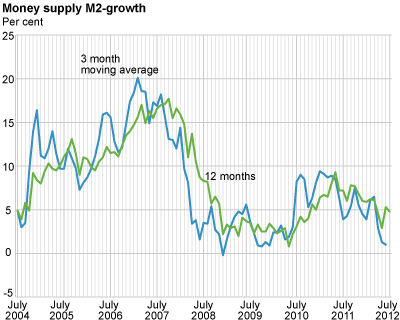Content
Published:
This is an archived release.
Decrease in money supply growth
The twelve-month growth in total money supply (M2) was 4.8 per cent to end-July, down from 5.3 per cent to end-June. The decrease stems from households and municipalities.
The total money supply amounted to NOK 1 777 billion at end-July, up from NOK 1 767 billion at end-June.
Decrease in money supply growth for households
Households’ money supply constitutes more than half of the total money supply. At end-July it accounted for NOK 972 billion, down from NOK 978 billion the previous month. The twelve-month growth in households’ money supply decreased from 8.4 per cent to end-June to 7.6 per cent to end-July.
The growth in households’ money supply was higher than the growth in households’ gross domestic debt, which amounted to 7.2 per cent to end-July, according to the credit indicator C2 . For more information on the financial position of households, see the financial accounts in the national accounts .
Increase in the money supply growth for non-financial enterprises
Non-financial enterprises’ money supply amounted to NOK 553 billion at end-July, up from NOK 536 billion at end-June. The twelve-month growth increased from 1.5 per cent to end-June to 2.5 per cent to end-July. Non-financial enterprises’ money supply constituted 31.1 per cent of the total money supply and 40.9 per cent of their gross domestic debt measured by the credit indicator C2 at end-July.
Decrease in money supply growth for municipal government
Municipal government’s money supply amounted to NOK 78 billion at end-July, down from NOK 83 billion the previous month. The twelve-month growth rate was -1.3 per cent to end-July, down from 5.8 per cent to end-June.
Increase in growth for other financial enterprises
Other financial enterprises’ money supply amounted to NOK 175 billion at end-July, up from NOK 169 billion at end-June. The twelve-month growth was -0.4 per cent to end-July, up from -1.2 per cent the previous month.
| January 2012 | Febuary 2012 | March 2012 | April 2012 | May 2012 | June 2012 | July 2012 | |||||||||||||||||||||||||||||||||||||||||||||||||||||||||||||||||||||||||
|---|---|---|---|---|---|---|---|---|---|---|---|---|---|---|---|---|---|---|---|---|---|---|---|---|---|---|---|---|---|---|---|---|---|---|---|---|---|---|---|---|---|---|---|---|---|---|---|---|---|---|---|---|---|---|---|---|---|---|---|---|---|---|---|---|---|---|---|---|---|---|---|---|---|---|---|---|---|---|---|
| M0 - 12 mth. | 35.9 | -5.1 | -13.8 | -0.4 | -19.7 | 1.9 | -19.2 | ||||||||||||||||||||||||||||||||||||||||||||||||||||||||||||||||||||||||
| M1 - 12 mth. | 5.5 | 5.4 | 5.9 | 3.7 | 1.1 | 5.0 | 2.6 | ||||||||||||||||||||||||||||||||||||||||||||||||||||||||||||||||||||||||
| M2 - 12 mth. | 5.9 | 6.2 | 6.1 | 4.6 | 2.9 | 5.3 | 4.8 | ||||||||||||||||||||||||||||||||||||||||||||||||||||||||||||||||||||||||
| M2 - 3 mth. moving average1 | 3.9 | 6.1 | 6.5 | 2.9 | 1.3 | 1.0 | |||||||||||||||||||||||||||||||||||||||||||||||||||||||||||||||||||||||||
| M2 households - 12 mth. | 7.3 | 7.3 | 8.2 | 7.8 | 8.2 | 8.4 | 7.6 | ||||||||||||||||||||||||||||||||||||||||||||||||||||||||||||||||||||||||
| M2 non-financial enterprises - 12 mth. | 3.5 | 4.7 | 3.0 | 0.4 | -3.6 | 1.5 | 2.5 | ||||||||||||||||||||||||||||||||||||||||||||||||||||||||||||||||||||||||
| 1 | Annualised figure. |
Composition of money supply
The broad monetary aggregate M2 amounted to NOK 1 777 billion at end-July, of which the major part, 91.8 per cent, consisted of bank deposits. In comparison, notes and coins only accounted for 2.6 per cent. The rest of the broad monetary aggregate consisted of shares in money market funds and certificates of deposits, which accounted for 5.3 and 0.2 per cent respectively.
Base money decrease
Base money (M0) amounted to NOK 93 billion at end-July, down from NOK 97 billion the previous month. The twelve-month growth in M0 decreased from 1.9 per cent to end-June to -19.2 per cent to end-July. This is caused by the banks’ decrease in F-deposits in Norges Bank compared to the same period last year.
The statistics is published with Monetary aggregates.
Contact
-
Statistics Norway's Information Centre
E-mail: informasjon@ssb.no
tel.: (+47) 21 09 46 42

